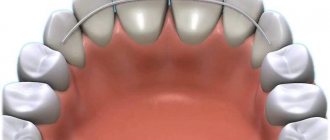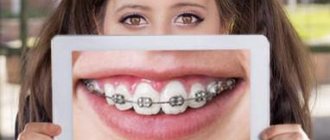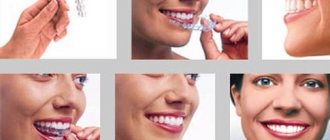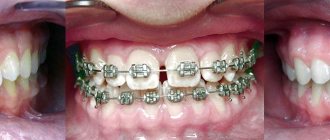This is a headache and a nightmare for any orthodontist: a patient who has had his braces removed and given a removable retainer and instructions for its use returns after some time with complaints about the curvature of his previously straight teeth. The retention period is the most psychologically difficult part of the treatment. Everything is already perfect, and then you have to wear a retainer. Yes, there are other reasons for the unsuccessful outcome of the correction. And although they are much less common, let’s talk about them in more detail.
Correction principle
The method of correcting malocclusion with braces is based on the principle of creating constant pressure on the teeth. Under pressure, the tooth root begins to press on the socket on one side, thereby causing rarefaction of the bone tissue. In the direction of rarefaction, the tooth moves. On the other side of the hole, bone tissue, on the contrary, grows. Thus, after a certain period of time, not only the position of the tooth changes, but also the shape of the socket, which prevents the tooth from returning to its original place.
Correct your bite or dental defect with invisible aligners Find out what it is
Bone tissue grows quite quickly, but it takes quite a long time to “ripen”. That is why, after finishing wearing the brace system, a removable retainer is made for the patient for another year or two or a splint is installed on the incisors and canines. Additional fixation during the retention period helps to avoid repeated tooth curvature.
Ceramic veneers for diastema
The problem is eliminated for a long time. But they will require more financial and time costs. To correct a small gap, two veneers will be enough only for the central two teeth: For a large distance, you will have to make veneers for four incisors: how to do it
- The dentist treats the outer surfaces of the teeth. He takes impressions and fixes the veneers to the teeth at the next meeting.
deadlines
- On average 3-7 days.
- If necessary, while prosthetics are in progress, temporary veneers are made from composite material.
pros
- They do not require high manual skills and experience from the doctor as with direct veneers.
- There is less plaque formation on ceramics than on your own teeth. It will never change color.
- You can change the color of your front teeth - make them lighter.
minuses
- The outer surfaces of the teeth are completely processed. There is an effect on the nerve of the tooth.
- If teeth are restored with large fillings, crowns will have to be made.
- Ceramic is a fragile material, so you will have to avoid biting into overly dense foods.
price
- For one veneer from 16,000 rubles and above.
forecast
- Service life up to 10 - 16 years.
- If damaged, they are completely rebuilt.
Negative consequences of diastema
In addition to aesthetic discomfort and impaired pronunciation of whistling sounds, the gap between the teeth causes inflammation of the gums and periodontium in this area.
Due to injury while eating. This will lead to gradual exposure of the roots of the front teeth. A short frenulum of the lip causes a greater negative impact. If attached close to teeth. It has a constant traumatic effect on the gingival margin around the teeth, causing chronic periodontitis. Then exposure of the roots occurs with bone tissue atrophy. And fast enough.
Prevention of diastema in adults
The distance between the central teeth appears in adulthood. There are several reasons:
- partial absence of chewing teeth,
- their destruction
- severe wear of teeth or fillings.
Then the front teeth begin to take on more chewing load.
If they do not have time to wear off, then they become compensatory. Provoking tilting of teeth and the appearance of gaps between teeth. This can be prevented by restoring the chewing function of the lateral teeth, avoiding overloading the front teeth.
Possible problems after removing braces
Some people's teeth diverge quickly after completing the correction stage. During the first year, some individuals may only slightly rotate around their axis. Everything is individual, but some general patterns can be identified.
Fanned teeth
A rapid relapse after braces are removed may be due to the following factors:
- Refusal of retainers. Patients often refuse permanent retainers because their installation damages tooth enamel. And it’s annoying to wear removable retainers, even those that are worn only at night. As a result, the teeth return to their previous position, since the new position has not yet been “overgrown” with bone tissue.
- Individual characteristics. There are people in whom new formation and “maturation” of bone tissue proceeds faster than others. And there are those for whom this process is delayed. For some, the displacement of teeth in order to correct the shape of the dentition was insignificant, while for others the tooth “came a long way” before taking its place in the dentition. Teeth quickly “huddle together” after crowding is eliminated. The teeth, which were mixed with braces around their axis, easily turn back.
- Breakage of braces, use of a system of inadequate quality. If the pressure on the teeth during correction was not constant, then the likelihood of an unfavorable outcome increases. You shouldn’t walk around with a broken arch or unstuck locks for a week. It is better to see a doctor on the same day. This will save you from many problems.
- Tooth extraction. When there is not enough space for teeth in the dentition, the orthodontist may decide to remove the “extra” ones. Most often these are fours, eights, less often sixes. The absence of fangs can cause the formation of a diastema. Removing a six causes significant displacement of adjacent teeth.
Loose teeth after braces
Occurs infrequently. In most cases, the feeling of excessive tooth mobility after removing braces is deceptive. It may appear at the very beginning of the retention period and disappear on its own and without treatment. It's another matter if the teeth are really loose. In this case, it is better to seek help from a specialist.
Pain in the teeth and gums
There may be some discomfort after removing braces. Pain occurs especially often after eating solid foods. The reason for this is a change in the condition of the ligaments that hold the roots of the teeth, as well as an increase in the sensitivity of the enamel if the remineralization procedure was not carried out. Reducing the chewing load and using special medications that reduce the sensitivity of teeth and gums help reduce pain.
Treatment of diastema in adults
There are several simple and effective ways to eliminate it. Some are quite fast - a couple of hours (closure with fillings), some up to 2 weeks (veneers) or more than a year (braces).
Correction of diastema with braces and aligners
Orthodontic treatment will eliminate the gap between the upper teeth in adults, and even more so in children.
It also normalizes the bite. It will create favorable conditions for chewing food and self-cleaning of teeth. how it's done
- Braces are placed on all teeth in one jaw. The orthodontist periodically changes the metal arches that connect the braces to each other. Due to this, the diastema closes. There are many options for braces: metal, ceramic, transparent, lingual and others. Read more about the types of braces here.
- If treatment is carried out with transparent aligners, the patient wears them around the clock. Taking off only while eating.
deadlines
- This is the longest treatment option for diastema.
- When the position of the remaining teeth is normal, it will take 8 months to close the gap.
- If there is a malocclusion and abnormal positions of some teeth. The terms will increase to 12 - 18 months.
- Treatment with aligners takes 18 to 30 months.
pros
- This treatment method will get rid of the diastema and also normalize the position of the remaining teeth and bite (if necessary).
- The teeth will not be treated by the dentist.
- Closes large gaps.
- Treatment is possible at any age. Examples with photos before and after orthodontic treatment are here.
minuses
- Long lead times for correction. Especially if only one distance between the central teeth is corrected, and the rest of the teeth are fine.
- It is not always possible to place braces on only one jaw. Often you have to use both.
- After the end of treatment, you have to maintain the result with retainers and mouth guards.
price
- This is the most expensive method for closing the space between teeth.
- When working with one jaw, the price of the entire treatment with all equipment is from 60,000 to 130,000 rubles. Depending on the type of equipment. If the work is carried out with two jaws, multiply by two.
forecast
- After orthodontic treatment, relapses of tooth displacement sometimes occur. Therefore, follow all doctor's instructions. Then the result obtained will be forever.
Causes of gaps between teeth
The main predisposing factors for the development of the defect:
- - presence of gaps in close relatives;
- - excessively pronounced interdental gingival papillae;
- — anomaly in the location of the labial frenulum;
- - delayed replacement of milk teeth with permanent ones;
- — congenital defects in the development of the dentofacial apparatus;
- — partial edentia or supernumerary teeth;
- - incorrect position of teeth (bite anomalies);
- - gum disease;
- - teeth are too small;
- — bad childhood habits (sucking pacifiers, fingers, chewing pens, pencils, etc.);
- - traumatic damage to the anterior teeth.
It is possible to prevent the occurrence of a gap between the front teeth by preventing diastema in childhood. All you have to do is take your child for a consultation to our clinic in St. Petersburg and get professional advice from an orthodontist.
Artistic restoration
If the space between the front teeth is small, it can be removed using a cosmetic restoration with a regular filling. To do this, the dentist will make a small filling between the incisors. This method of treating gaps between the front teeth has several advantages:
Defect resolution speed. You can get rid of an unsightly gap between your front teeth by visiting a dentist;
Low price. The cost of eliminating a gap between teeth with a filling will be 3-4 thousand rubles.
But this method of eliminating the gap between the front teeth has its drawbacks. The filling may change color, break, and its installation increases the risk of caries in the joint between the teeth.
The artistic restoration process also uses composite filling materials to fill gaps between teeth. But the dentist will apply them in a special way - in layers. This technology allows you to obtain the most aesthetic and long-lasting restoration results (compared to conventional fillings).
Removing gaps between teeth using artistic restoration is more expensive than installing a conventional filling.
If you have eliminated the space between your front teeth using artistic restoration and want the positive results to last for a long time, try to reduce the load on the front teeth. To do this, do not gnaw with your incisors, and especially do not try to gnaw something hard with them: nuts, seeds.
Why is the jaw pushed forward and why is it dangerous?
The development of maxillofacial pathology most often begins in infancy or even in the prenatal period. Almost half of the cases are due to hereditary factors, but there are a number of external reasons why the jaw protrudes forward:
- taking medications during pregnancy that lead to the development of fetal pathology;
- injuries sustained by the baby during childbirth;
- rickets suffered at an early age;
- too short frenulum of the tongue;
- bad habits in infancy - prolonged pacifier sucking, sleeping in the wrong position;
- prolonged biting of lips, cheeks, fingers or any objects (for example, sucking the lower lip and thumb leads to lengthening of the upper teeth, and the upper lip - the lower);
- lack of solid food by the time chewing teeth erupt (at 2.5 - 3 years), which leads to impaired chewing function;
- incorrect posture;
- premature loss of baby teeth;
- diseases of the ENT organs and associated difficulties in nasal breathing.
All types of malocclusion have a significant impact on appearance. People with a protruding lower jaw appear gloomy and angry, and their facial features appear rough. Those with a distal bite often slouch and tilt their heads forward, and a small chin is associated with a weak character. But aesthetic problems are not the only difficulty that patients face.
Moving the jaw forward can lead to a number of other disorders:
- joint mobility is impaired and pain occurs;
- the likelihood of diseases of the temporomandibular joint increases;
- diction is impaired;
- difficulties arise with chewing food, gastrointestinal diseases develop;
- due to malocclusion, tooth enamel may wear down unevenly;
- the risk of periodontal disease/periodontitis increases;
- persistent disturbances in sound pronunciation appear, persisting even after 6–7 years (dyslalia);
- Dental prosthetics becomes more complicated.
- Due to improper redistribution of the chewing load, caries more often affects the back teeth.
How to close a gap between your front teeth
External and lingual braces
Braces are one of the most famous and popular ways to eliminate the problem of incorrect teeth position.
Even until relatively recently, the aesthetic side of the issue repelled many patients from wearing braces, especially teenagers. After all, they were made exclusively from metal and were attached from the outside. Therefore, the gap between the teeth, in addition to everything, also became a psychological problem. During treatment, patients complained about their appearance. Modern medicine has made significant progress in this direction: orthodontists now recommend lingual braces to patients. Since they are attached to the back surface of the teeth, they remain almost invisible. In some cases, even braces are not needed to eliminate gaps - doctors prescribe aligners (transparent aligners).
Lingual braces have one minor drawback - the patient takes longer to get used to such microprostheses than to the external type.
Braces can be plastic or metal, ceramic or sapphire. The former are noticeably cheaper, but they are not as durable as their metal counterparts. Ceramic and sapphire look very aesthetically pleasing. When choosing one option or another, it is worth consulting with a doctor, who will point out certain characteristics of one or another option and the priority of specific models for you. After all, for example, sapphire braces will not look beautiful on those who have a yellow tint to their teeth.
Installation of braces is carried out in two ways - direct and indirect. In the first option, the orthodontist, checking his actions with the photographs, installs the locks individually, one on each of the teeth. This work is almost like jewelry, since it is extremely important to maintain maximum precision. In most cases, orthodontists today resort to this method.
The second is indirect. Experts are convinced that this is the future. The orthodontist makes an exact plaster copy of the teeth and places clasps on it. Afterwards everything is transferred to a mouthguard, which is placed on the dentition. That is, the doctor fixes the system at the same time. This method is very convenient for both the orthodontist and the patient.
The material and design of high-quality modern braces in no way affects the effectiveness of treatment. Typically, a microprosthesis is worn for 1-2 years. The period depends on many factors, including the characteristics of the individual’s body.
The use of braces is considered the most correct method, even tooth-friendly. If we are talking about treating teenagers, then you should resort exclusively to braces.
Do I need to get rid of the gap?
To correctly answer this question, you need to understand what kind of diastema we are talking about. It may be true or false. Is there any way to eliminate the space between a child’s teeth?
False diastema is not uncommon in children with baby teeth. After their shift, she can leave on her own.
A true diastema is one that arose after the formation of a bite and the replacement of baby teeth. Visible space will no longer disappear on its own. Its owner may experience malocclusion, poor diction, and dental problems. Also, for many, the cause of complexes is a gap. Therefore, you should definitely get rid of this diastema.











